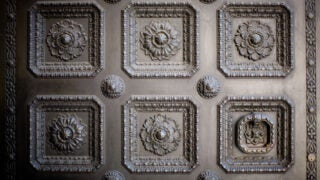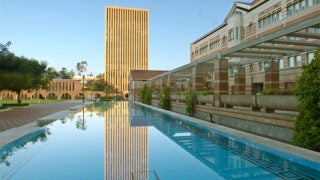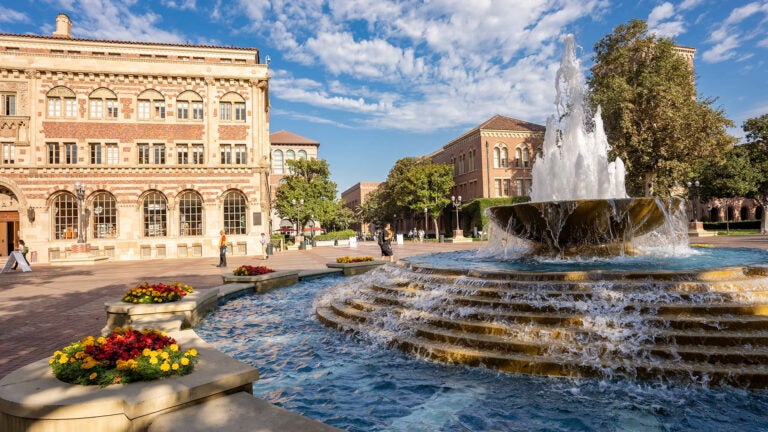
Located In Hahn Central Plaza, the Shumway Fountain heralds your arrival at the nucleus of the campus. (Photo/Chris Shinn)
Everything you never knew you wanted to know about USC fountains
Here’s the TFM guide to all things USC fountains — from tidbits of trivia and lore to insights on their benefits and delights.
As the summer heat descends on Los Angeles, the most refreshing spots at USC can be found next to the cool waters of its 41 fountains — 38 on the University Park Campus and three on the Health Sciences Campus.
Featuring spouts of dancing water, geyser-like sprays, waterfall flows and more, USC’s varied fountains are iconic fixtures within the university’s distinctive grounds. They not only cool the surrounding air but also offer rejuvenation for the mind and spirit. In the fountains’ splashing waters, you might even hear the whispers of USC history.
“Each fountain at USC has its own story,” says Jon Soffa, who has served as the university architect in Facilities Planning and Management for nearly three decades.
Jets of jubilation
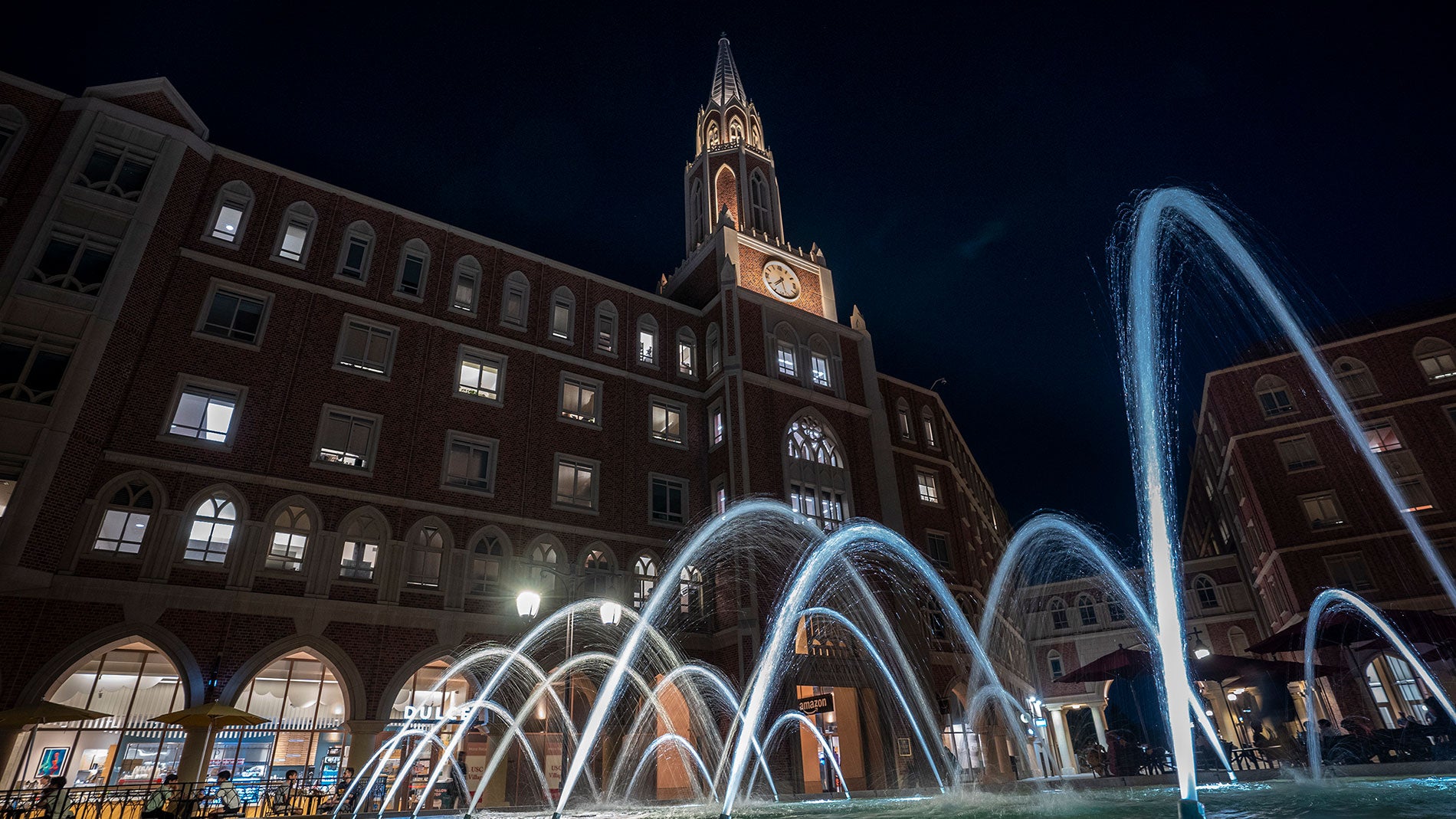
USC’s fountains, large and small, help define the campus’ character and mirror its energies. The University Park Campus’ grandest sprays provide a lively backdrop to the hustle and bustle of campus activities and serve as community gathering points.
In Hahn Central Plaza, the Shumway Fountain — a gift of donors Patsy and Forrest Shumway — is one of the most jubilant. Its dozen-plus jets of water gush skyward with celebratory pomp, and its vigorous waterfall sound is a herald that you’ve arrived at the nucleus of the campus. On busy days, students stream through the plaza as robustly as water flows through the spouts.
When first built, the Shumway Fountain burst forth like a geyser from the ground. A makeover in the summer of 2012 added a raised platform and bowl, flower planters and tiered seating, making it a popular spot for students to congregate.
USC’s newest fountain, the Fubon Fountain, built in 2017, is a similar focal point for the goings-on at USC Village’s central piazza, where students and faculty shop, dine and meet for conversation. As the crowds ebb and flow, the fountain can morph from a symphony of arching water spouts to a calm reflecting pool, thanks to programmable jets lining its perimeter.
“Fountains are places of convergence,” says Jennifer Parga, associate teaching professor of practicum education at the USC Suzanne Dworak-Peck School of Social Work and a community-building expert. “They galvanize people to come together.”
The sound of a fountain’s rushing water can help facilitate those connections. Joon-Ho Choi, associate professor of architecture and director of the USC Center for Wellness in the Built Environment, notes that fountains generate “pink noise,” a comfortable frequency that provides acoustic privacy for personal conversations.
Fountains of knowledge
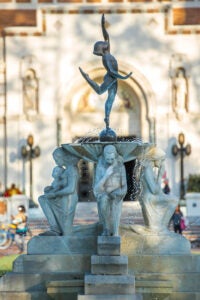
Fountains’ shimmering water invites reflection — “meaning not only a reflection of sunlight, but reflection as in thinking,” Soffa says.
Since ancient times, fountains have been symbols of the pursuit of knowledge. The gentle sound of flowing water may even facilitate studying, as pink noise can help improve focus and concentration.
Most libraries at USC have a fountain or two just a stone’s throw away for thoughtful study breaks. The university’s most famous fountain, Youth Triumphant, is situated in Alumni Memorial Park near the main entrance to Doheny Memorial Library. Film buffs might remember that it appeared in the 1967 film The Graduate.
The fountain is a replica of Bavarian sculptor Frederick William Schweigardt’s The Four Cornerstones of American Democracy fountain, which was displayed at the 1935-36 California Pacific International Exposition in San Diego. Donors Robert Carman-Ryles and his wife presented the replica to USC in 1935 in memory of their son, alumnus Edward L. Prentiss. In 1979, it was recast and reinstalled after being damaged in 1976 by falling trees.
At the base of the fountain’s bowl, four kneeling female figures cast in concrete represent democratic cornerstones: School, Home, Community and Church. A bronze figure of Youth dances, well, triumphantly atop a globe. The sculpture’s symbolism offers plenty of food for thought.
Other favored fountains for contemplation include the USC Mudd Hall of Philosophy courtyard fountain and the tiled wall fountain in Reunion Courtyard at the rear entrance to Doheny Memorial Library, which provides the perfect soundtrack for pondering the meaning of life while sipping an icy beverage from the adjacent LiteraTea teahouse.
“O stream of life run you slow or fast, all streams reach the sea at last.” — Inscription on the fountain in the USC Mudd Hall of Philosophy courtyard
A slice of paradise
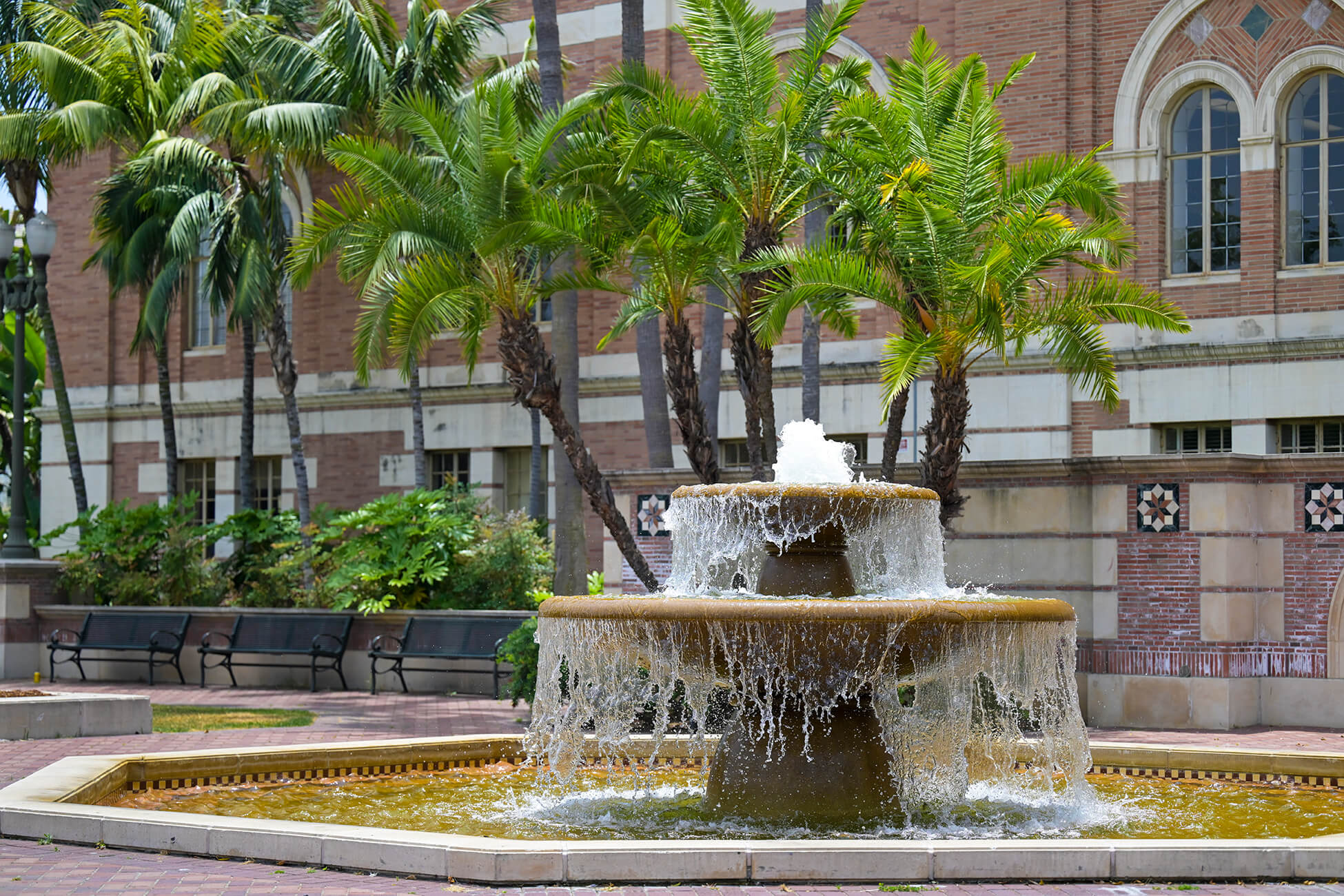
At the southern edge of the McCarthy Quad, a large, two-tiered fountain babbles in the center of the Carolyn Craig Franklin Library Garden Courtyard. A plaque invites visitors to “Take Time to Smell the Flowers” — advice attributed to the courtyard’s namesake. Franklin, who passed away in 1993, was a longtime USC volunteer, wife of vice president emeritus and law professor Carl M. Franklin, and posthumous recipient of the USC Presidential Medallion.
The sound of water is worth more than all the poets’ words.
— Octavio Paz, Nobel laureate
Ringed by benches, date and fan palms, and lush plantings, the fountain is one of many on campus particularly well-suited to rest and refreshment — whether from the stresses of midterms or the heat of an August day. The garden setting evokes ancient Persian gardens where fountains were first used as part of landscapes for aesthetic, cooling and spiritual purposes.
“Not coincidentally, the Avestan language in ancient Iran used the word ‘pairidaeza’ to refer to these gardens, and that’s the root of the English word ‘paradise,’” says Ciruce A. Movahedi-Lankarani, Farhang Foundation Early Career Chair in Iranian Studies and assistant professor of Middle East Studies in the USC Dornsife College of Letters, Arts and Sciences.
Soffa, the university architect, notes that fountains work on our senses to soothe us at multiple levels. The sound of rushing water can drown out unpleasant noises and induce relaxation. Feeling the cooler air and perhaps even water droplets on our skin provides a calming tactile experience. Even the mere sight of water can bring relief when we’re overheated because of its associations with cooling.
The serenity imparted by fountains makes them an important part of biophilic design, which seeks to connect urban landscapes to nature to promote well-being. “Interacting with a natural element like water has been shown to reduce stress and improve mood,” Choi says. “The presence of a water feature can also stimulate mindfulness and a meditative state.”
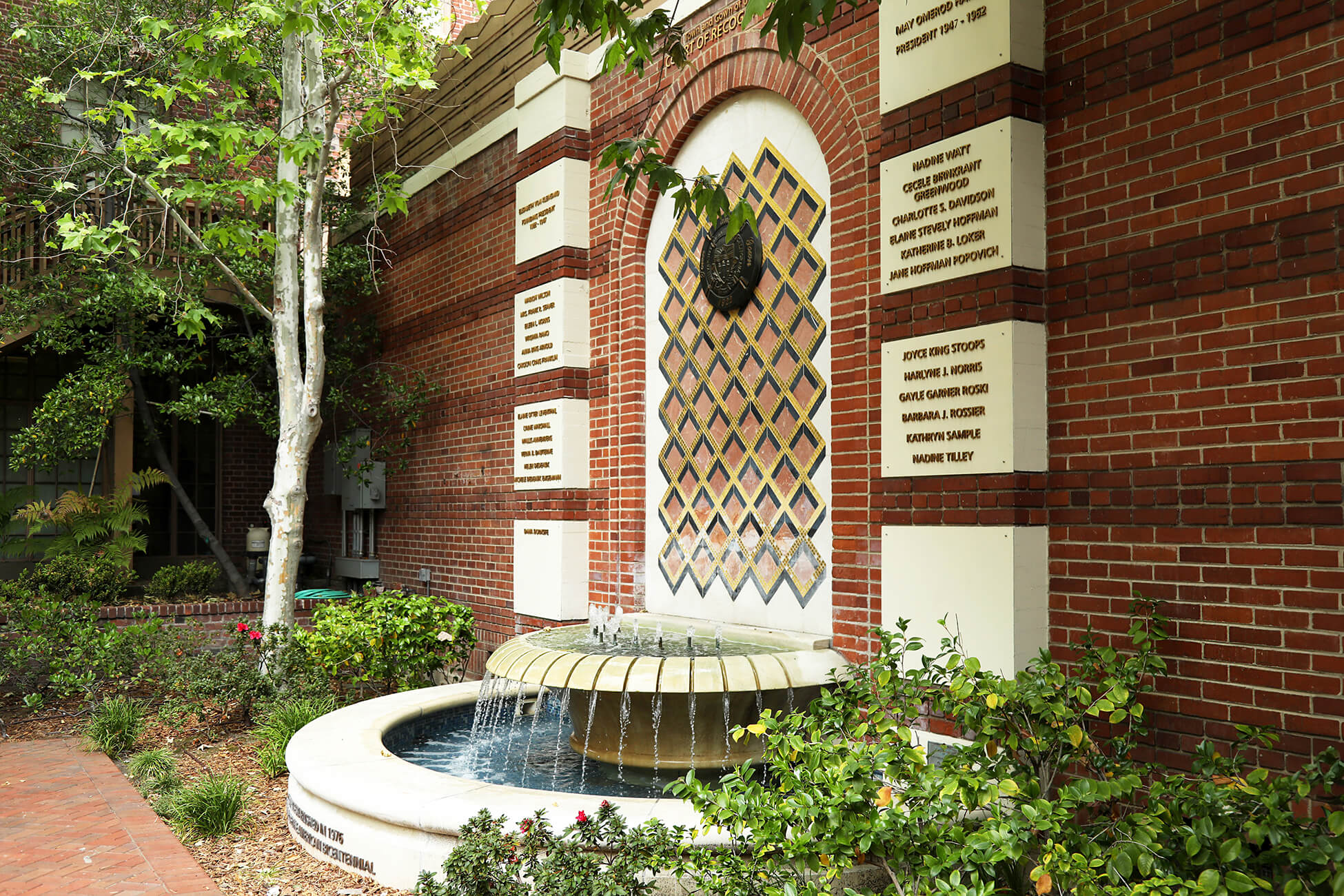
While the fountain on McCarthy Quad offers a measure of quietude within a high-traffic part of campus, other tucked-away fountains promise more hidden respites. Examples include the wall-mounted fountain on the sunken patio outside the Vineyard Room of the Davidson Continuing Education Center and the cardinal and gold-tiled fountain in the courtyard just outside the serene Little Chapel of Silence, between Town and Gown and Hubbard Hall.
On the Health Sciences Campus, the Richard K. Eamer Medical Plaza Fountain provides a soothing backdrop to the flurry of activity at the adjacent Keck Hospital of USC. Its lofty spouts of water cascade into a large, placid pool, providing patients and doctors a rejuvenating nature break amid the stresses of medical care.
Legends and legacies
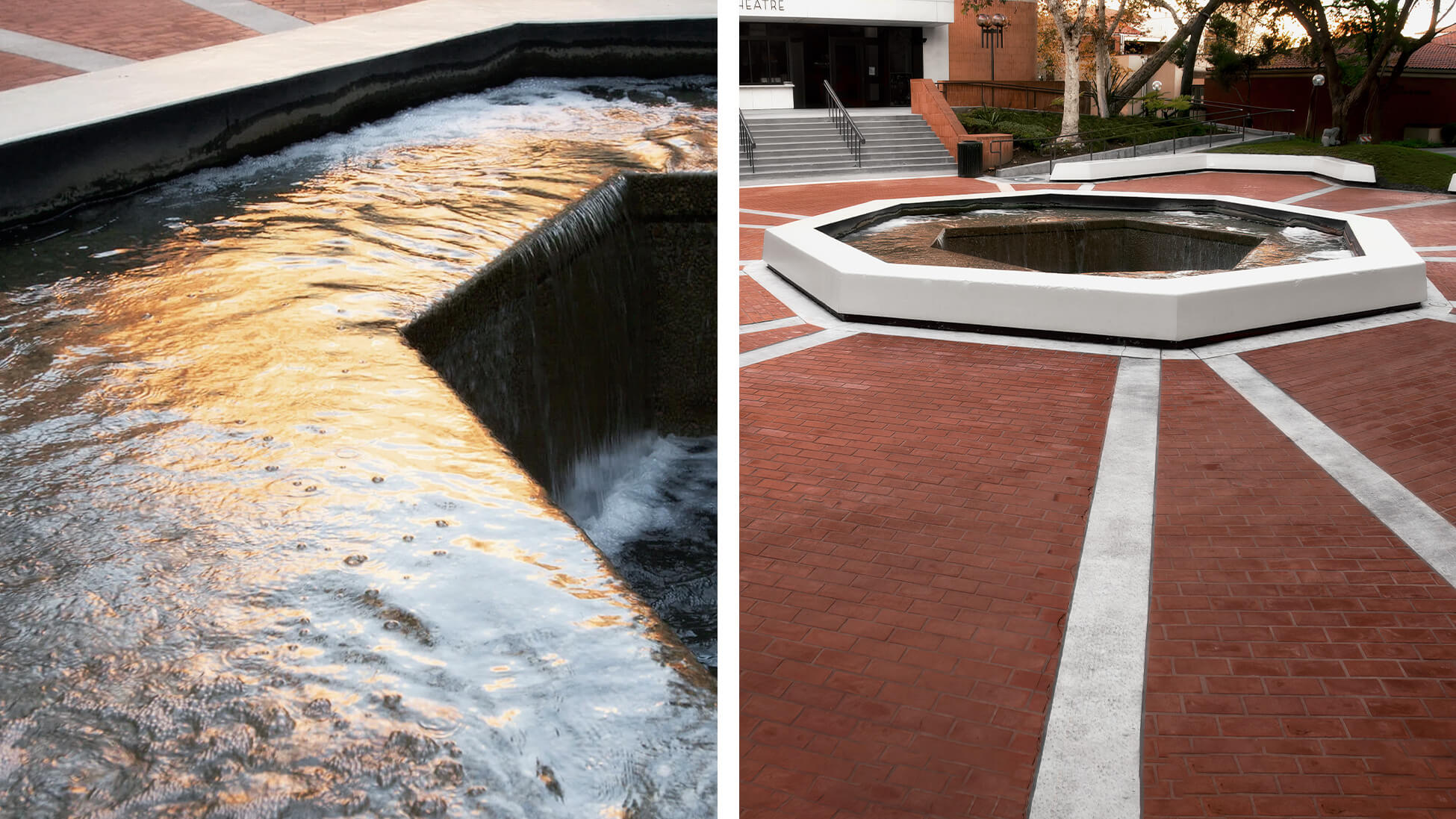
The inverted fountain at the center of Queens Courtyard, which lies between the Bing Theatre and the Eileen L. Norris Cinema Theatre, is the subject of a USC urban legend. As the story goes, the two buildings’ donors were supposedly so fiercely competitive that when the theaters were both built in the mid-1970s, their desire to keep a figurative eye on one another allegedly influenced the octagonal fountain’s design. Its water flows down to a basin below ground level, leaving the view unobstructed from one building to another.
Another tidbit of lore involves a bygone fountain at the north end of Trousdale Parkway in Gavin Herbert Plaza. Students nicknamed the Cubist fountain the “Finger Fountain” because it resembled a certain well-known (vulgar) hand gesture, allegedly pointed in the direction of UCLA (though it actually pointed north rather than northwest to this crosstown rival). The fountain was demolished in 2016 as part of major improvements to the plaza that established safer and more convenient connections between the core University Park Campus, USC Village and surrounding neighborhoods served by University Walk.
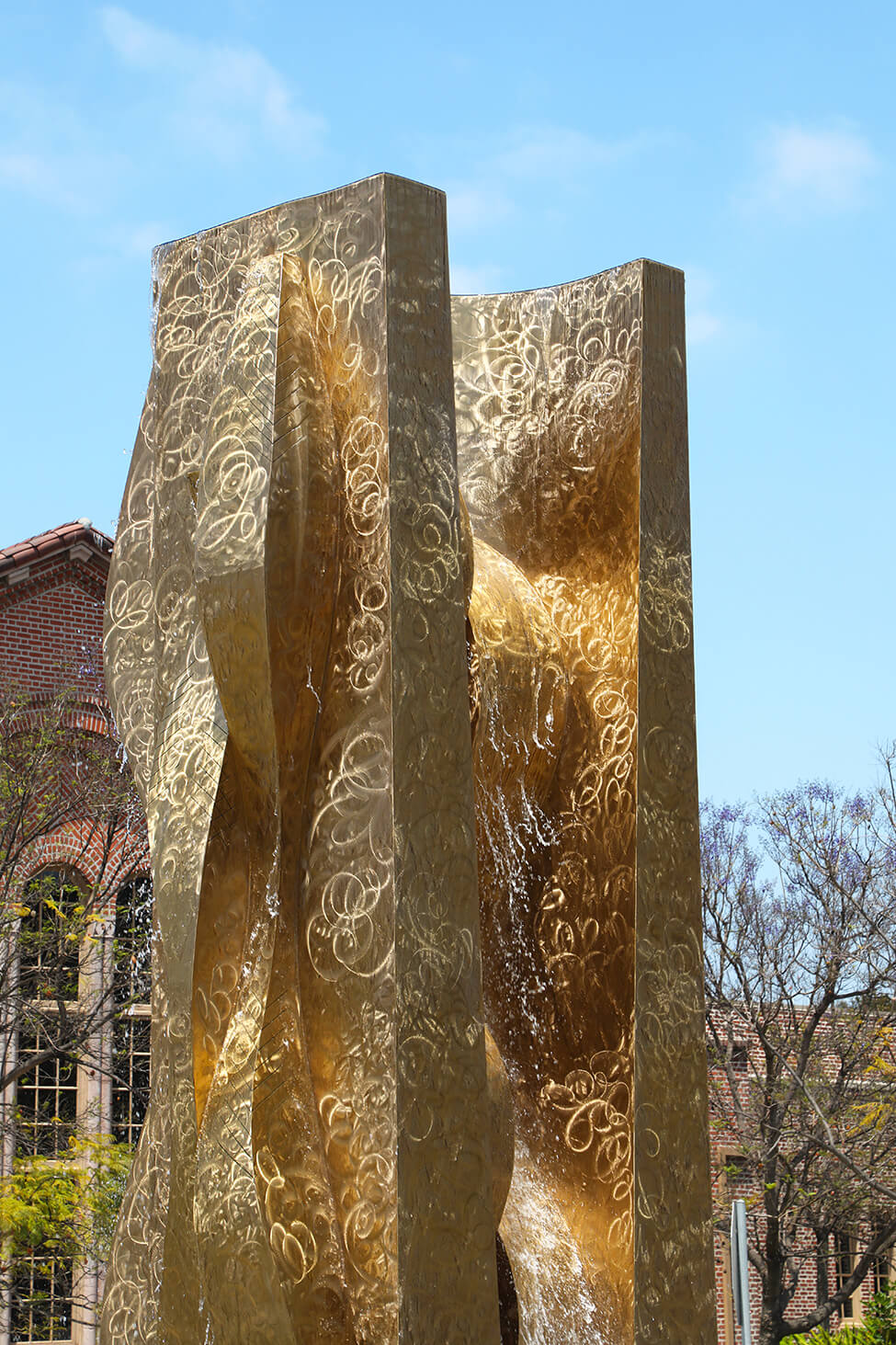
This past winter, the Generations Fountain, situated just west of Leavey Library, got a face-lift of sorts. The 21-foot-high sculpture was gifted to USC in 2009 by Bettina and John Deininger, representing the three generations of their family members who have attended USC and honoring all Trojan families and their legacies.
When it was first crafted by sculptor Aristides Burton Demetrios, the silicon bronze fountain had a brilliant gold sheen. The passage of time and exposure to the elements oxidized the bronze, rendering it a dull black color. A detailed restoration completed in January returned the fountain to its original color in weeks.
Like a Taylor Swift costume change, the transformation from black to gold proved dazzling — especially for recently arrived Trojans who had only known the fountain as black. “It took a lot of students and staff by surprise,” says Stephanie Kowalick, the director of collections, compliance and exhibitions at the USC Fisher Museum of Art, who helped coordinate the restoration process. “It’s really nice to see it restored to its previous glory.”
The restoration is just one example of how USC ensures that as the generations pass, the campus’ distinctive fountains continue flowing — in top form.
Keeping USC’s fountains water wise
Fountains account for approximately 2% of all water usage at the university. USC works to ensure the fountains are operated and maintained as efficiently as possible:
- Each fountain runs on a schedule that is adjusted seasonally and for special events.
- Pumps recirculate the water, reducing the need to refill fountains regularly.
- Several fountains have a wind sensor and shut down under windy conditions when water blows out.
- All fountains are shut down over winter recess.
- Several fountains are metered. Data is downloaded and reviewed on an internal dashboard. This data is monitored to identify water-saving opportunities.
For more information on USC fountains:
- Read the book Fountains & Flourishes of the University of Southern California, published in print in 2010 and online in 2012.
- Visit this web archive on the fountains compiled by university librarian Ruth Wallach, last updated in 2014.
- Check out this video tour of USC fountains.

